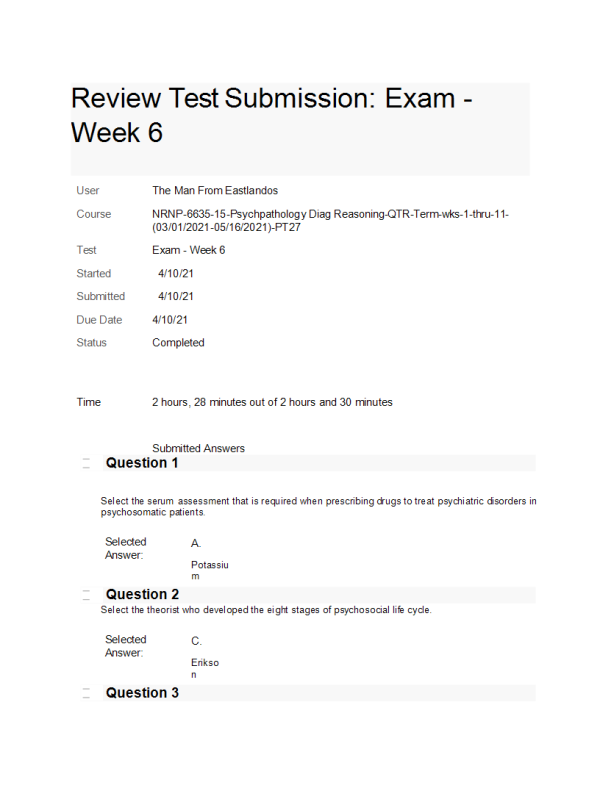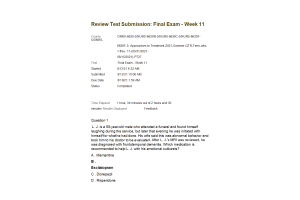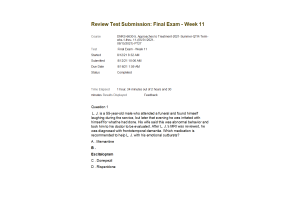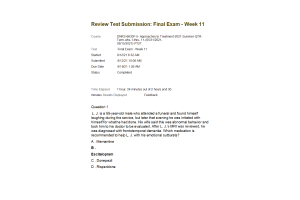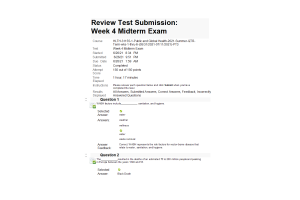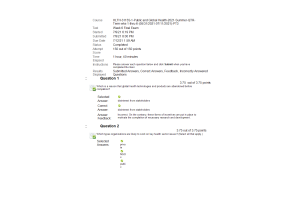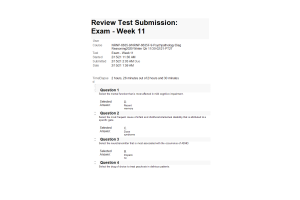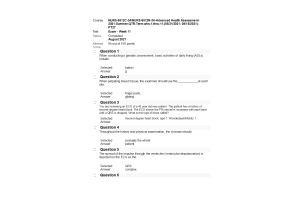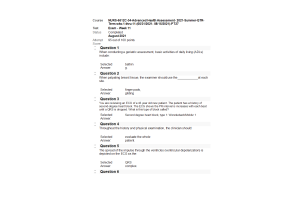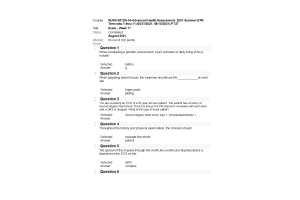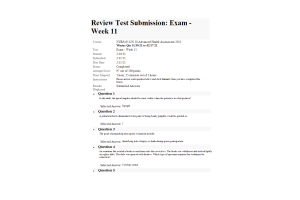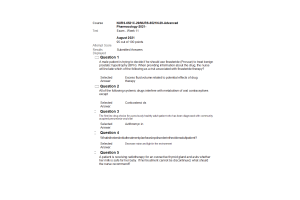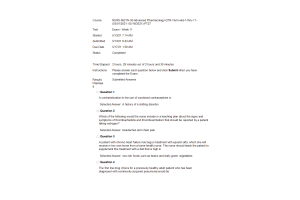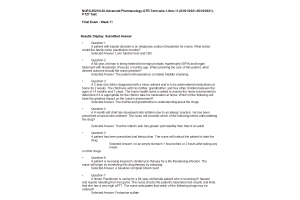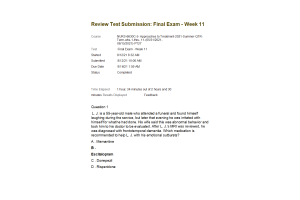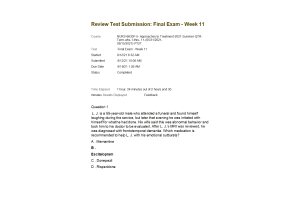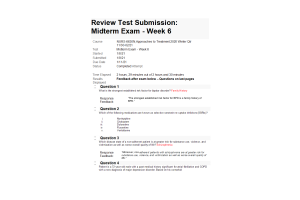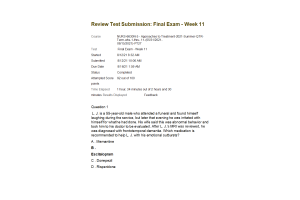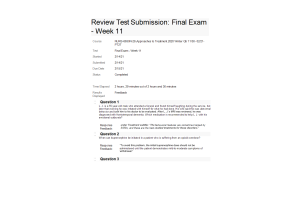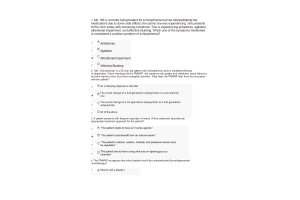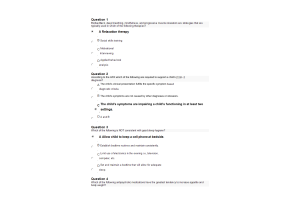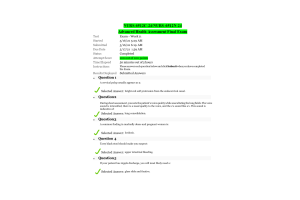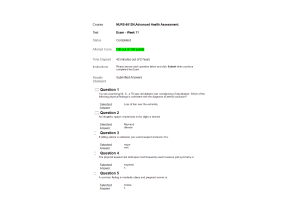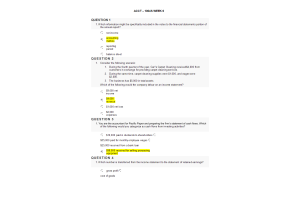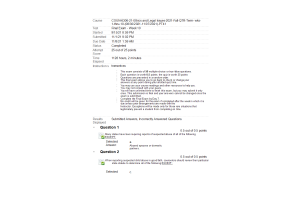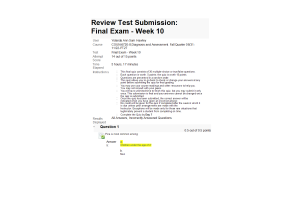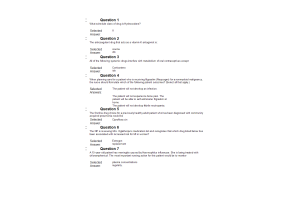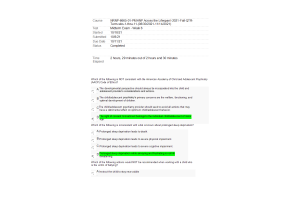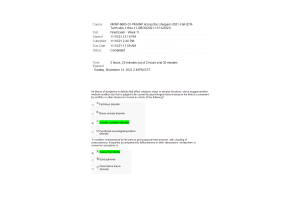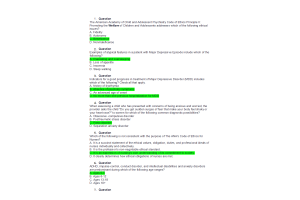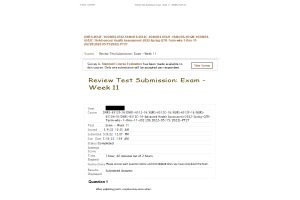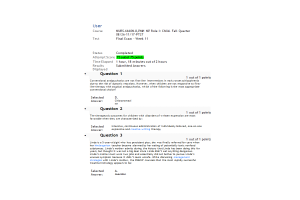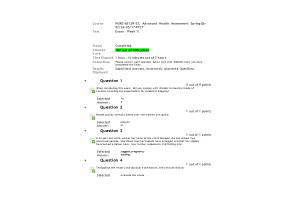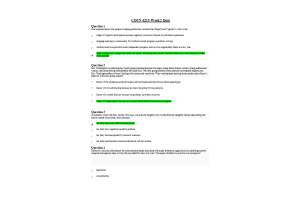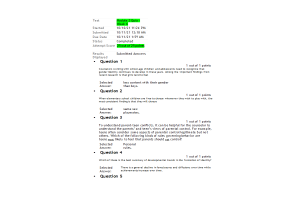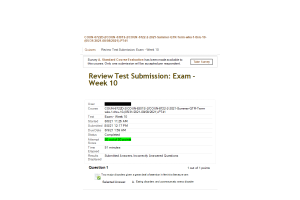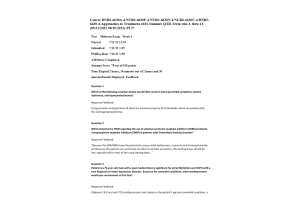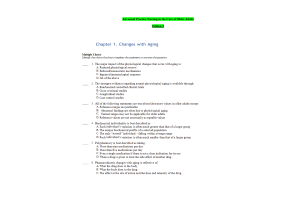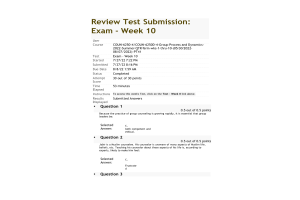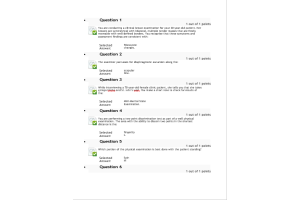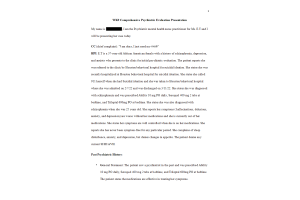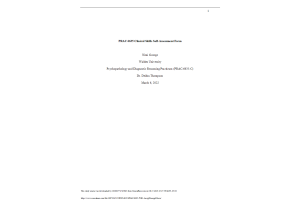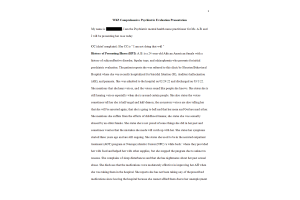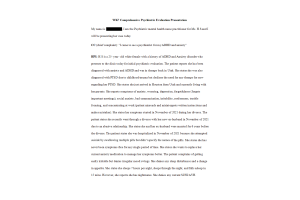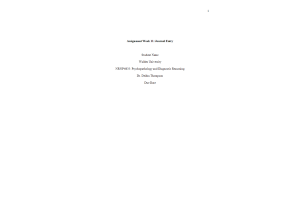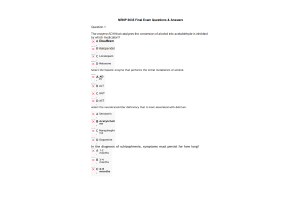NRNP 6635-15, Week 6 Midterm Exam
- $49.00
- Question: Select the serum assessment that is required when prescribing drugs to treat psychiatric disorders in psychosomatic patients.
- Question: Select the theorist who developed the eight stages of psychosocial life cycle.
- Question: Select two causes of dissociative amnesia.
- Question: Select the patient evaluation scale to be used before and during prescribing antipsychotic drugs.
- Question: Select the two comorbid disorders with which Pica occurs most commonly.
- Question: Select the prognosis range of untreated PTSD patients.
- Question: Select the memory category retained in transient global amnesia that is absent in dissociative amnesia.
- Question: The following is NOT an endocrine change noted with anorexia nervosa:
- Question: Select the two most important elements of the psychiatric interview to establish a mental illness diagnosis.
- Question: Select the greatest impediment to treating anorexia nervosa patients.
- Question: Select the sleep disorder in which cataplexy is a common symptom.
- Question: Select the obsessive-compulsive disorder for which a patient is likely to initially seek help from a Primary Care Provider.
- Question: Select the rating scale used to assess obsessive-compulsive disorder.
- Question: Select age after which encopresis may be correctly diagnosed.
- Question: Select the mood disorder that is worsened by chronic exposure to observing violence in television, movies, and video games.
- Question: Select a provider’s most important knowledge area essential to a successful mental health interview of a child.
- Question: Select the minimum treatment time to assess the effectiveness of antidepressant drug therapy.
- Question: What is one main difference between acute stress disorder and PTSD?
- Question: Factors that indicate a good prognosis for PTSD disorders include all the following EXCEPT:
- Question: Select the medical condition that must be excluded as a cause of somatic symptom disorder or hypochondriasis.
- Question: What is the most IMMEDIATE consideration in assessing depression in adolescents?
- Question: Select the neurotransmitter that is most involved in the pathophysiology of schizophrenia.
- Question: Select the most important component of the patient-provider rapport.
- Question: Select the most effective treatment for social anxiety disorder in children.
- Question: All the following are key psychiatric findings when assessing speech and language in children EXCEPT:
- Question: Select the factor that is required to cause PTSD from a stressor.
- Question: All the following are classes of coping mechanisms in the Model of Mental Health as Resilience where humans overcome stressful situations EXCEPT:
- Question: Anatomical and functional neuroimaging studies have associated a decreased activation in what part of the brain with obsessive-compulsive behaviors?
- Question: Select the two complications in diagnosing patients with anorexia nervosa.
- Question: Select the anxiety disorder that emerges in ages 9 to 18 months.
- Question: Select the two most common peripheral symptoms of anxiety.
- Question: Select the hormone or neurotransmitter that is involved in regulating the 24-hour circadian sleep-wake cycle.
- Question: Select the event most associated with the occurrence of dissociative fugue.
- Question: Select the neurodevelopmental disorder typically diagnosed in childhood.
- Question: Select the primary cause of reactive attachment disorder in children.
- Question: Select the psychiatric disorder for which drug and nondrug treatments are least effective.
- Question: Select two events that are causes of dissociative trance disorder.
- Question: Select the time from occurrence of the stressor in which symptoms must appear to diagnose an adjustment disorder.
- Question: Select the serum substance that should be measured to aid the diagnosis of restless leg syndrome.
- Question: Select the DSM-5 disorder formerly called multiple personality disorder.
- Question: Differential diagnosis for consideration when suspecting a cyclothymic disorder include:
- Question: The following psychotherapy interventions is NOT a recommended in the treatment of PTSD:
- Question: Select the difference in rates of suicidal thoughts and behaviors between placebo and drug in children and adolescents observed from random controlled trials of nine antidepressant drugs that resulted in the 2004 FDA “black box” warning in labeling of
- Question: Select the drug that has been effective in treating social anxiety in children.
- Question: Select the youngest age range at which alarm therapy is effective to treat enuresis.
- Question: Which part of the brain is essential to the maintenance of attention?
- Question: Select two signs and symptoms of bulimia nervosa.
- Question: Select the behavior that best describes early onset bipolar disorder in children and adolescents.
- Question: Select the most common stressor of PTSD in women.
- Question: Select the most likely stressor to cause an adjustment disorder.
- Question: Select the motivation in pyromania that is absent in patients who commit arson.
- Question: What does a black-box warning from the FDA indicate for prescribers?
- Question: Select the third most commonly reported psychiatric symptom.
- Question: Select the disorder in which patients feel detached from their environment.
- Question: Select the least extent of sleep debt that can cause hyper somnolence.
- Question: Select the disorder in children and adolescents that is described by depressed or irritable mood for most of the day for a majority of days in at least one year.
- Question: Select the disorder in which children are irritable and display temper outbursts, but are not likely to cause physical harm to themselves and others.
- Question: Select the nondrug therapy approved for use in patients who have failed to achieve satisfactory improvement with correctly prescribed antidepressant drugs.
- Question: Fetal alcohol syndrome is characterized by all the following EXCEPT:
- Question: Select the age stage of life in which identity crisis typically emerges.
- Question: Select the brain region that is most implicated in the function of memory.
- Question: Select the two most effective treatments for obsessive-compulsive disorder (OCD) in children and adolescents
- Question: Select two types of theories that have contributed to causes of anxiety.
- Question: Select the self-report rating scale used to screen for major depression.
- Question: Select the two symptoms that result from prolonged sleep deprivation.
- Question: Select the least effective method to treat dissociative amnesia.
- Question: Select the short rating scale used to assess change in psychiatric inpatients.
- Question: Select the two diverse symptoms of OCD.
- Question: Select the antidepressant drug that is effective in treating OCD, because it is the most selective in preventing serotonin uptake
- Question: Select the drug in addition to a benzodiazepine used to treat generalized anxiety disorder.
- Question: Select the percent of OCD patients who also have depressive symptoms.
- Question: Episodes of major depression and hypomania are the main characteristics of:
- Question: Benzodiazepine treatment for anxiety conditions lasts for:
- Question: Select the comorbid disorder most frequently associated with anorexia nervosa.
- Question: Which side effect of venlafaxine places the medication as a second-line choice when compared with SSRIs?
- Question: Select the therapy for insomnia that can be effective at up to three years after discontinuation.
- Question: Select the two types of symptom patterns common to OCD patients.
- Question: Select the percentage range of correlation between obesity and psychiatric disorders.
- Question: Select the largest percentage prevalence of psychiatric disorders in patients hospitalized for medical conditions.
- Question: Select the symptom that is most likely improve early in the drug treatment of major depression.
- Question: Select the most effective treatment found in the studies of adolescents with depression.
- Question: Select the mood disorder in which diagnosis requires symptoms present for at least two years.
- Question: Select the two most commonly co-occurring anxiety disorders that may present with generalized anxiety disorder.
- Question: Select the factor that best correlates with the occurrence of PTSD in children.
- Question: Select two events that are excluded as causes of dissociative trance disorder.
- Question: According to Bowlby’s theory of anxiety, what is fundamental to the growth of attachment in an infant?
- Question: Select the preferred treatment for bulimia nervosa.
- Question: Select the greatest challenge in the long-term treatment of Bipolar I and II disorder.
- Question: Select the life stage at which emotional and social behavior begin.
- Question: Select the symptom that is least associated with manic and hypomanic episodes.
- Question: Select the two primary psychometric properties of psychiatric rating scales.
- Question: Select the theorist who developed psychoanalysis.
- Question: Select the disorder that is most similar to cyclothymia.
- Question: Select the public performance that is most associated with social anxiety in children.
- Question: Select the antidepressant drug most likely to cause sexual dysfunction.
- Question: Select the theorist who is credited with establishing the area of psychosomatic medicine.
- Question: Select two common uses of items taken in kleptomania.
- Question: Select the age group in which adjustment disorders occur most frequently.
- Question: Select the percent rate of mortality in anorexia nervosa patients.
- Question: Select the two rating scales used specifically for schizophrenia.
- Question: When completing this exam, did you comply with Walden University’s Code of Conduct including the expectations for academic integrity?
